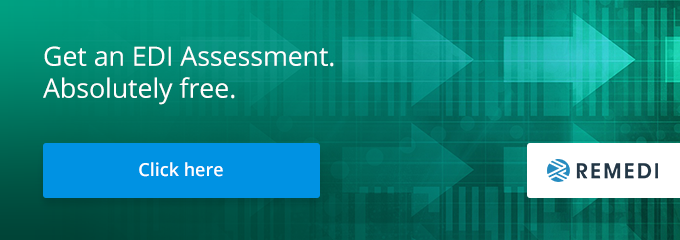
Electronic Data Interchange (EDI) is a long-standing technology with a history spanning over 60 years. Over the years, it has transformed, evolved, and faced fierce competition, yet it has remained the most dominant utility for B2B communications. Despite the proliferation of internet-enabled transactions, businesses across numerous industries still develop and maintain their systems around EDI standards. In 2019, EDI accounted for 78.4% of all B2B electronic transactions.
Recently, however, EDI's role in facilitating B2B interactions has faced some scrutiny. With the pandemic dramatically upsetting global supply chains, several businesses and industry experts are questioning whether EDI is still the best mode of interaction among trading partners.
Nevertheless, the vast majority of EDI users are not showing any signs of abandoning EDI standards. In this article, we discuss why EDI is still the most preferred facilitator of B2B transactions today.
Businesses Need Seamless, Automated Data Exchange
EDI's undeniable strength is its ability to streamline business operations. An EDI upgrade enables companies to share information in a seamless, fluid manner that eliminates the many touchpoints of traditional paper-based data exchange processes.
Using EDI standards to share data replaces human intervention with machine-to-machine interaction, saving both the sender and receiver significant time and effort. As a result, trading partners can reinforce B2B collaboration and effectively respond to both opportunities and risks.
Below are five compelling benefits of integrating EDI that make it a must-have for modern-day enterprises.
- Automated Transactions
Conventionally, B2B transactions like sales orders, purchase orders, invoices, advance ship notices, and functional acknowledgment involve numerous paper documents and significant human intervention, which exposes them to a high risk of error. With EDI, businesses can eliminate paper documents and minimize human intervention, resulting in faster and more accurate transaction processing.
- Enhanced Efficiency
The automation of data exchange through EDI contributes to increased efficiency levels. Rather than spending time processing paper documents or translating files from one format to another, trading partners can share information using pre-determined standards that are understandable by all systems in the supply chain. That way, enterprises can divert staff members from menial, repetitive activities to more critical, value-adding tasks.
- Ensure Transaction Security
EDI enhances transaction security by enabling secure data sharing across a vast array of security standards and communication protocols.
- Agile Responses to Disruption
In today's exceedingly dynamic supply chains, agility is of the utmost importance. By automating processes, EDI speeds up business transactions by as much as 61%. Timely data transfer through EDI solutions enables trading partners to identify underlying issues along the supply chain and deploy quick, efficient responses.
- Reduced Operational Expenses
EDI reduces an enterprise's operating costs by at least 35% by eliminating paper, printing, filing, postage, and document retrieval expenses. More significantly, the fast responses to supply chain shake-ups through EDI transactions enable businesses to avoid an insurmountable financial exposure.
EDI Is Constantly Evolving to Keep Up with User Demands
Although the advantages of using EDI for B2B transactions are enthralling, they do not fully explain why alternative formats like XML and JSON or technologies like blockchain and API are yet to challenge the EDI monopoly. After all, these other solutions offer virtually the same automation benefits as EDI, including faster transactions, efficiency, security, agility, and cheaper transactions.
The primary reason EDI has been resilient amid formidable competition is it has kept evolving with the changing needs of its users.
At the start of EDI's history, the only communication method was direct EDI, based on on-premise solutions. Since then, EDI has morphed into a vast range of solutions, including AS2, FTP, Web EDI, Cloud EDI, and mobile EDI, and opened its arms to the most innovative, AI-powered tools for mapping, routing, and workflow creation.
Today, every enterprise, big or small, has a shot at a solution that answers their needs, be it simple EDI mapping or a comprehensive system with advanced functionalities. Moreover, EDI now covers almost all transaction types across many different industries. Therefore, regardless of your business or the scale of documents you exchange with your partners, you can implement EDI to streamline your transactions.
Besides constant technological developments, EDI standards and regulations are updated when required through air-tight processes that ensure functionalities remain useful for years to come.
EDI Will Continue to Dominate B2B Data Transmission Well into the Future
Given today's unprecedented business environment, it is unsurprising that EDI's role as the key enabler of B2B transactions is under review. However, the reality is that EDI is a long-standing protocol that still works well for its users. EDI helps improve supply chain processes through faster, cheaper, secure, automated transactions. When appropriately implemented, a robust EDI solution can lower your supply chain costs, improve your adaptability, and reinforce relations with your trading partners.
As a leading provider of EDI integration consulting services, Remedi boasts a roster of experienced and skilled EDI consultants that can set you up with a flexible, scalable EDI solution that is specifically tailored for your needs.
That way, rather than worrying about EDI deployment tasks like updating your communication channels, recruiting staff, or onboarding customers, you can start thinking about how you will leverage robust partner interactions to create a sustainable supply chain.



